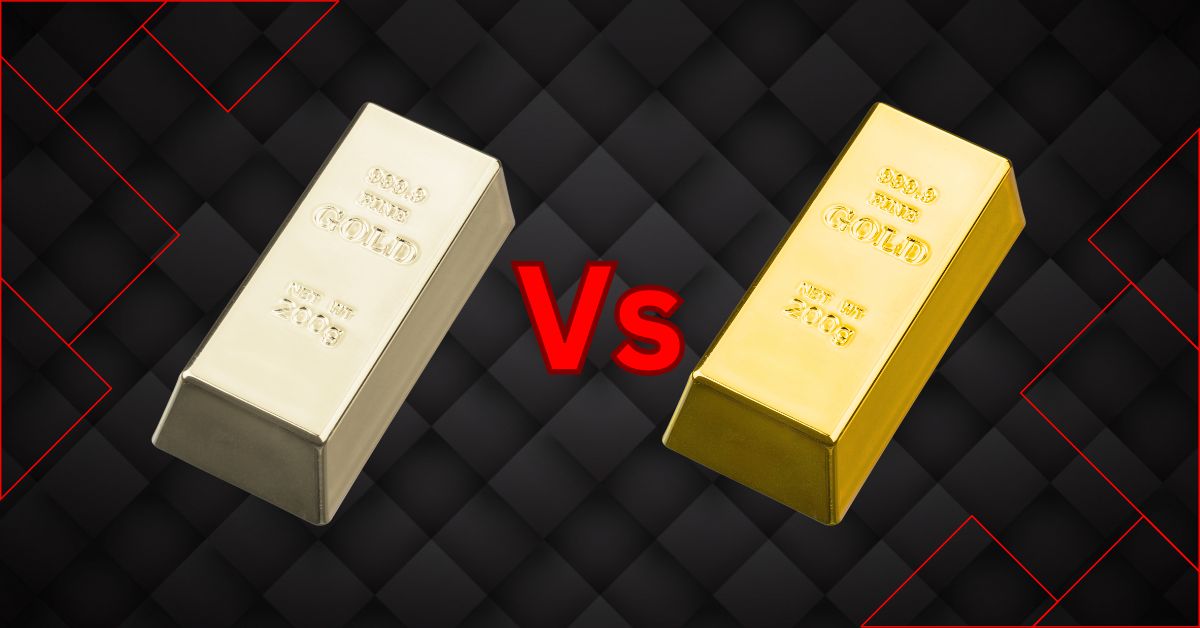When choosing the perfect piece of jewelry, whether it’s an engagement ring, wedding band, or everyday accessory, one of the biggest decisions you’ll face is selecting between white gold vs yellow gold. Both are popular choices, each offering its own unique qualities and aesthetics. However, deciding which one is right for you depends on your preferences, budget, and lifestyle.
In this article, we’ll break down the 5 key differences between white gold and yellow gold, explore their pros and cons, and help you make the best choice for your next jewelry purchase.
1. What Is White Gold and Yellow Gold?
Before diving into the differences between white gold vs yellow gold, it’s important to understand what they are. Both white and yellow gold are made from pure gold, but they differ in terms of color, composition, and how they are created.
Yellow Gold
Yellow gold is the classic and traditional form of gold, made by mixing pure gold with metals like copper and zinc to create a durable alloy. Pure gold is naturally yellow, but it is too soft to use in its pure form for jewelry, so it is mixed with stronger metals to make it suitable for everyday wear.
White Gold
White gold, on the other hand, is created by blending pure gold with white metals such as palladium, nickel, or silver. After the alloy is formed, the piece is typically coated with rhodium, a shiny white metal that gives white gold its bright, reflective finish. The rhodium coating adds extra durability and enhances the color of white gold, making it appear more silver-like.
Though both types of gold start as pure gold, the different metal alloys mixed with them create the contrasting appearances and properties.
2. Top 5 Differences Between White Gold and Yellow Gold
While white gold and yellow gold share the same base element, there are key differences between them that can influence your decision when buying jewelry. Here are the top 5 differences you should know:
1. Color
- White gold has a silvery, reflective finish, thanks to its rhodium plating, while yellow gold maintains the warm, classic golden hue that is often associated with traditional jewelry.
2. Composition
- White gold is an alloy made with white metals like palladium or nickel, whereas yellow gold is mixed with metals like copper and zinc to maintain its natural yellow color.
3. Durability
- White gold tends to be slightly more durable due to its rhodium plating, which makes it more resistant to scratches. Yellow gold, especially in higher karat forms (18K or 22K), is softer and more prone to dents and wear.
4. Maintenance
- White gold requires regular maintenance to maintain its shine, as the rhodium coating can wear off over time and need re-plating. Yellow gold, while less prone to color change, may still need occasional polishing to keep its luster.
5. Price
- The price of white gold vs yellow gold can vary depending on the purity (karat) and the metals used in the alloy. White gold may be slightly more expensive due to the rhodium plating and higher alloy costs, but both are typically priced similarly.
These differences will help guide your choice based on what you value most—color, durability, or maintenance.
3. White Gold vs Yellow Gold: Which Is More Durable?
When it comes to durability, both white gold and yellow gold have strengths, but their durability largely depends on the karat level (purity) of the gold and the metals they are mixed with.
White Gold Durability
White gold is often considered more durable than yellow gold because of the rhodium plating that adds a protective layer to the jewelry. The rhodium not only gives white gold its brilliant finish but also makes it more resistant to scratches and tarnishing. However, white gold can lose some of its luster over time, especially if the rhodium coating wears off, which means it may need re-plating every few years.
Yellow Gold Durability
Yellow gold is softer, especially in higher karats like 18K or 22K, which contain more pure gold and less alloy. The higher the karat, the softer the metal, making it more prone to scratches and bending. 14K yellow gold, which is more commonly used for jewelry, strikes a balance between durability and gold content.
If you’re looking for jewelry that will withstand daily wear and tear, white gold may offer more durability, especially for engagement rings or items worn frequently.
4. Pros and Cons of White Gold vs Yellow Gold
Both white gold and yellow gold have their own advantages and disadvantages depending on your lifestyle, taste, and needs. Here’s a breakdown of the pros and cons for each:
White Gold Pros
- Modern, sleek look: White gold has a contemporary appearance that pairs well with both diamonds and colored gemstones.
- More durable: Rhodium coating makes white gold more scratch-resistant.
- Versatile: Complements cool skin tones and modern jewelry designs.
White Gold Cons
- Maintenance: Requires re-plating every few years to maintain the rhodium coating.
- Allergies: Some people may be allergic to the nickel found in certain white gold alloys.
Yellow Gold Pros
- Classic and timeless: Yellow gold offers a warm, traditional look that never goes out of style.
- Hypoallergenic: Yellow gold in higher karats (18K or above) is less likely to cause allergic reactions.
- Less maintenance: Requires less frequent upkeep compared to white gold.
Yellow Gold Cons
- Softer and less durable: Prone to scratches and dents, especially in higher karat forms.
- Not as versatile: May not complement all skin tones or gemstone colors as well as white gold.
Understanding the pros and cons of white gold vs yellow gold will help you choose the option that best fits your lifestyle and aesthetic preferences.
5. White Gold vs Yellow Gold for Engagement and Wedding Rings
Choosing the perfect metal for your engagement ring or wedding band is a major decision, as these pieces are meant to last a lifetime. Here’s how white gold vs yellow gold compares for such significant pieces of jewelry:
White Gold for Engagement Rings
- White gold is often favored for engagement rings because its sleek, silver-like appearance pairs beautifully with diamonds. The brightness of white gold enhances the sparkle of diamonds, making it a popular choice for modern and contemporary ring designs.
- It’s also durable enough for everyday wear, making it a practical option for a ring you’ll wear frequently.
Yellow Gold for Wedding Bands
- Yellow gold, on the other hand, is often associated with wedding bands due to its timeless and romantic appeal. The warm glow of yellow gold is perfect for couples seeking a more traditional look.
- Yellow gold is also a great option for those who prefer vintage or classic styles, as it has been the standard choice for wedding rings for centuries.
Ultimately, the decision between white gold or yellow gold for engagement and wedding rings comes down to personal preference, with each metal offering its own aesthetic and practical benefits.
6. White Gold vs Yellow Gold: Which Matches Your Skin Tone?
When choosing between white gold vs yellow gold, it’s important to consider which metal best complements your skin tone:
White Gold for Cool Skin Tones
- If you have a cool skin tone with blue or pink undertones, white gold is a great match. Its cool, silvery hue complements fair and cool-toned skin, giving a sleek and polished look.
Yellow Gold for Warm Skin Tones
- Yellow gold is ideal for people with warm skin tones, characterized by yellow or olive undertones. The rich, warm color of yellow gold enhances the natural glow of warm skin tones, making it a flattering choice for many.
If you have a neutral skin tone, you’re in luck—both white gold and yellow gold will look great on you!
7. Price Comparison: White Gold vs Yellow Gold
The price of white gold vs yellow gold can vary based on factors like the karat level, metal content, and any additional treatments (such as rhodium plating). However, in general:
- White gold tends to be slightly more expensive than yellow gold because of the rhodium plating process and the cost of white metal alloys like palladium.
- Yellow gold, particularly in 14K form, is typically more affordable since it doesn’t require the same level of maintenance or additional coatings.
When budgeting for your jewelry, keep in mind the potential long-term costs associated with white gold, such as re-plating.
8. Which Is Better for You: White Gold or Yellow Gold?
The decision between white gold vs yellow gold ultimately comes down to your personal preferences, lifestyle, and budget. Here’s a quick guide to help you choose:
- Choose white gold if: You prefer a modern, versatile look that pairs well with diamonds and colored gemstones. White gold is also great for those who want a more durable option for everyday wear.
- Choose yellow gold if: You love a timeless, classic aesthetic with warm tones. Yellow gold is also ideal if you prefer a lower-maintenance option or have a warm skin tone that suits the golden hue.
By considering these factors, you can confidently choose the gold that best fits your style and needs.
For more exciting blogs, visit our homepage Magzineco.com
Conclusion
Whether you’re drawn to the sleek, modern appeal of white gold or the timeless warmth of yellow gold, each type of gold offers its own unique benefits. Understanding the key differences between white gold vs yellow gold—from durability and maintenance to price and aesthetic—will help you make an informed decision when choosing your next piece of jewelry.
Whether for an engagement ring, wedding band, or an everyday accessory, choosing between white gold vs yellow gold ultimately comes down to personal preference and how you want your jewelry to reflect your style.
FAQs About White Gold vs Yellow Gold
- What’s the difference between white gold and yellow gold?
- White gold has a silvery finish due to rhodium plating, while yellow gold maintains a natural golden hue. They also differ in composition and durability.
- Which is more durable, white gold or yellow gold?
- White gold is more durable due to its rhodium plating, which protects it from scratches, while yellow gold is softer, especially in higher karat forms.
- Is white gold more expensive than yellow gold?
- White gold can be slightly more expensive due to the rhodium plating and the cost of white metal alloys like palladium or nickel.
- Which is better for engagement rings: white gold or yellow gold?
- White gold is often preferred for engagement rings because its bright, silvery appearance enhances the sparkle of diamonds.
- Do I need to re-plate white gold?
- Yes, white gold requires re-plating every few years to maintain its rhodium coating and bright finish.
- Which gold complements warm skin tones better?
- Yellow gold complements warm skin tones, while white gold suits cool skin tones.
- How can I maintain yellow gold jewelry?
- Yellow gold requires occasional polishing but generally needs less maintenance than white gold.
- What is the best gold for everyday wear?
- White gold is generally more durable for everyday wear due to its rhodium coating, while 14K yellow gold is also a good option for durability.
- Does yellow gold tarnish?
- Yellow gold does not tarnish, but it may lose its luster over time and require polishing.
- Can I mix white gold and yellow gold jewelry?
- Yes, mixing white and yellow gold is a popular trend, allowing for a unique and modern jewelry style.




